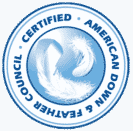Students Sleep Better With Down and Feather Bedding
Tips on How to Create the Best Dorm Room Rest from The American Down and Feather Council
NEW YORK, NY (MAY 5, 2011) –An essential component to staying focused in school is a good night’s sleep. Unfortunately, most college students do not get the sleep they need to thrive. The best way to combat lack of sleep in students is to ensure that they are fitted with proper bedding.
Not only comfortable and stylish, down and feather comforters and pillows are an effective way to help get a good night’s rest. The American Down and Feather Council (ADFC) has put together a few tips to help students and their parents choose the best possible bedding to outfit their dorm rooms.
- Know your Firmness Preference – Would you prefer to feel like you’re sleeping on a cloud, or do you want a little more support? Compare the ratio of down to feathers. Pillows with a high percentage of down are the softest, a greater blend of down and feathers will provide a more firm sleeping surface, and all-feather pillows will deliver the most support.
- Check out the Insulation Quality – Fill power measures the insulating ability of down comforters. Comforters with high fill power will keep you warmer with less weight. Look for a fill power number of 550 and above when choosing a down comforter.
- Choose a Construction Type – Construction of the pillow or comforter impacts on its overall comfort and durability. In a comforter, look for sewn-through boxes or baffle box construction. In those that are sewn-through, the top and bottom fabric are stitched together, preferably in a box pattern. Baffle box construction features three dimensional boxes created with strips of fabric. Both of these construction types prevent shifting of the filling, keeping you warm and cozy. Whether buying a pillow or comforter, check that the seams are sturdy.
- Make sure the Products are Downproof – To keep the down and feathers from leaking out or “downproof,” the product’s shell should have a thread count of at least 230. Higher thread counts are not necessarily better, but it takes a minimum of 230 to be considered downproof.
- Look For and Understand the Label – Federal and state regulations specify how down and feather products may be labeled. In the U.S., any product that is labeled as a down comforter is required by law to contain at least 75% down.
About ADFC
The American Down and Feather Council, a section of the Home Fashion Products Association, is a voluntary association of manufacturers of natural-fill bedding products, as well as dealers, buyers, sellers and processors of feathers and down for use in home fashion products. The goal of the ADFC is to further the common interests of the down and feather products industry, and to maintain and improve product quality. The objective of the ADFC Labeling Compliance Program is to ensure all natural-fill bedding products. For additional information on down and feather bedding visit the ADFC’s Website at www.downandfeather.org.
About HFPA
Established in 1968, The Home Fashion Products Association (HFPA) is the premier association for companies involved in the home fashion products industry. Committed to industry excellence, members primarily include companies that manufacture and market curtains, draperies, bed and bath fashions, table linens and allied products, as well as companies that manufacture, market and convert fabrics, linings, trimmings and/or other component materials for curtains, draperies, bedspreads, table linens and allied products.

